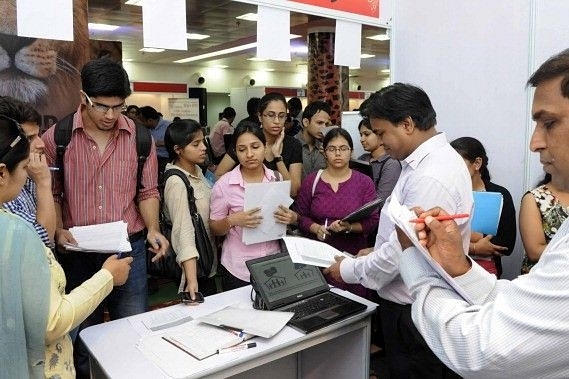Economy
India’s Growth Challenge Remains, But Jobs Problem May Start Shrinking Soon
- According to data released recently, in the next decade, India’s employment issue looks less of a challenge, but economic growth remains a concern.

Students at a campus job fair organised by Delhi University Students Union in New Delhi. (Sushil Kumar/Hindustan Times via GettyImages)
The good news: India’s jobs problem is going to look less problematic in the coming decade. The bad news: India’s growth rate will also be tougher to move upwards of the 8 per cent mark in the coming decade.
These indicative conclusions flow from two sets of data released by the Sample Registration Survey (SRS) of the Registrar General of India and the Economic Survey 2018-19 prepared under the supervision of Chief Economic Adviser K V Subramanian, and released by Finance Minister Nirmala Sitharaman on 4 July.
The SRS data showed that India is now close to achieving a total fertility rate (TFR) of 2.2, where 2.1 is the replacement rate of the population. From 2.4 per couple in 2012, it is down to 2.2 in 2017. While Delhi, Andhra Pradesh, Telangana, Jammu and Kashmir, Punjab, Tamil Nadu, West Bengal, Karnataka, Kerala, Maharashtra, Odisha and Uttarakhand have already fallen below 2.1, three others are getting there (Gujarat, Haryana and Assam with 2.2-2.4). Only Chhattisgarh, Jharkhand, Rajasthan, Madhya Pradesh, Bihar and Uttar Pradesh are still high in terms of TFR, in the range of 2.7-3.5, with Bihar being a prolific producer of kids at the top end of the scale.
When TFR starts falling, the demographic dividend slowly starts reversing in terms of growth rates, especially if the working age population also starts growing at a slower rate.
The Economic Survey 2018-19 postulates that, adjusted for the lower sex ratio (which has dropped to 896 girls per 1,000 boys at birth in 2015-17), India’s real TFR is probably already at 2.1, since fewer women in child-bearing age means that there will be fewer number of wombs available for bearing children in future.
Says the Survey: “It will surprise many readers to learn that population in the 0-19 age bracket has already peaked due to sharp declines in total fertility rates (TFR) across the country. …As a result, the national TFR is expected to be below replacement level by 2021 (adjusted for the skewed gender ratio, it may already be there).”
But, more importantly, “the age distribution…implies that India's working-age population will grow by roughly 9.7 million (mn) per year during 2021-31 and 4.2 mn per year in 2031-41.”
The implications are huge for jobs. If, two years down the line, new entrants to the job market will be down to 9.7 million (and not the much-touted figure of 12-15 million annually), the need for new job creation will be far lower. If we assume that the labour force participation rate (LFPR) is 50 per cent of the working age population, the new job-seekers will fall below 5 million annually. At a 60 per cent LFPR, which means more women joining the workforce, we need to create less than six million new jobs annually in the next decade. After 2030, we will have even fewer net accretions to new job-seekers.
But if you think the jobs problem is close to getting solved, think again by considering the observe side of the coin. A slowing rate of growth in population, and especially working age population, means that gross domestic product (GDP) growth could also slow down, unless most of the additional growth comes from higher productivity, including automation and capital investment.
Ruchir Sharma, an investment professional, wrote in The Times of India three years ago that global growth will drop by around 1 per cent from 3.5 per cent to 2.5 per cent due to the sharp drop in working age population. He wrote: “this is a critical turning point. Worldwide, growth in the working age population has collapsed, from an annual average of about 2 percent before 2005 to an annual average post-war low of around one percent this year (2016). This one percentage point drop in population growth is likely to take a roughly equal chunk out of potential population growth, which means that the world needs to reset its expectations.”
What Sharma said about the world depopulation trend is becoming true about India too – or, rather, is looming ahead in the 2020s. Our jobs challenge will ease off, but our growth challenge remains.
However, if we define the Indian jobs challenge as a wages problem, a slowdown in net accretions to the working age population will start pushing wages up slowly towards the second half of the next decade. This means the wages currently on offer are not enough to get people off the unemployment registers to actively seek jobs. This problem of jobs will, it seems, remain with us over the rest of Narendra Modi’s second term.
He has to focus on getting wages up by continuing to encourage formalisation and investment in sectors with high employment elasticities.
Support Swarajya's 50 Ground Reports Project & Sponsor A Story
Every general election Swarajya does a 50 ground reports project.
Aimed only at serious readers and those who appreciate the nuances of political undercurrents, the project provides a sense of India's electoral landscape. As you know, these reports are produced after considerable investment of travel, time and effort on the ground.
This time too we've kicked off the project in style and have covered over 30 constituencies already. If you're someone who appreciates such work and have enjoyed our coverage please consider sponsoring a ground report for just Rs 2999 to Rs 19,999 - it goes a long way in helping us produce more quality reportage.
You can also back this project by becoming a subscriber for as little as Rs 999 - so do click on this links and choose a plan that suits you and back us.
Click below to contribute.
Latest